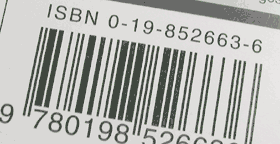ISBN Information
ISBN means International Standard Book Number. ISBNs give a unique identifier to every edition of a book published (and also to many book-like products, including e-books). A publisher will assign a different ISBN to the paperback edition of a particular book than to the similar hardback edition.
There is no requirement to assign an ISBN to any book, but a publisher will find that for all practical purposes it is necessary to adopt the ISBN system for its books to be adopted by the book trade.
ISBNs are used throughout the life of a publication, from early planning and production stages, through to publication, promotion, sales, distribution, stocking, sales analysis, rights management, bibliographic data storage and library information management. A key factor of the system is that it can be both human- and machine-readable.
The ISBN system is recognised in over 170 countries, regions or language groups throughout the world.
ISBNs are used for a wide range of publications and media. ISBNs are not just used for print media, but identify a range of media types including audio books on cassette, CD and DVD, as well as other electronic media including the many forms of e-book such as those from Apple and Amazon; microform media such as microfilm and microfiche; educational computer software as well as publications that consist of a range of media types, where the component is text based.
ISBNs should not be used for products where the principle component is not based upon a monographic text based publication. Publications unsuitable for the ISBN system include those that are ongoing and unconcluded, such as bibliographic resources, newspapers and periodicals; the abstract intellectual property of a work, such as a novel (while a particular publication of the novel would have an ISBN); printed ephemera such as advertising leaflets; printed music; art prints without text; personal resumes and curriculum vitae; greetings cards; recordings of music; non-educational software; emails or other electronic communication.

Other systems exist for publications that do not come within the range of the ISBN system. These include the ISSN (International Standard Serial Number) used for magazines, periodicals and journals and the ISMN (International Standard Music Number) used for printed music.
If it is unclear whether a publication is suitable for the ISBN system, help should be sought from your regional ISBN authority.
History of International Standard Book Numbering
If you are interested in the history of the ISBN system, then see the History of the ISBN System page.
The 10-digit ISBN
Up until the end of 2006, ISBNs comprised ten digits. See the Anatomy of a 10-digit ISBN page to understand how they work.
The 13-digit ISBN
From 1st January, 2007 all new ISBNs are 13-digits in length and will be integrated into the larger group of product numbering known as EAN used for products that are retailed internationally. Originally EAN meant European Article Number, but since international adoption it officially means International Article Number, but the abbreviation EAN is retained. For information about how 13-digit ISBNs work and how they relate to EANs, see the Anatomy of a 13-digit ISBN page. For information specifically about the EAN system, see the International Article Number page.
Administration of the ISBN System
ISBNs are created by publishers by way of their national ISBN authority. In the USA, the national ISBN authority is R. R. Bowker and for the United Kingdom and the Republic of Ireland it is Nielsen BookServices. For further details of these and other national ISBN authorities, see the Administration of the ISBN system page.
How to Obtain ISBN numbers
Do you need to get an ISBN number for a book you have written? Take a look at the pages that deals with buying ISBNs and self publishing. Do you want a single ISBN number? See the Get a Single ISBN page.
ISBN Barcodes
The ISBN barcode that you find on the back cover of most books is a particular example of the barcode found on a very wide range of consumer products found throughout the world and which conforms to the International Article Numbering standard. If you need a fairly complete and technical understanding of how the ISBN barcode works - how the ISBN number is encoded in the system of stripes on the ISBN barcode and how to both encode an ISBN number to the barcode and decode the ISBN barcode stripes into an ISBN number, then you need to study the ISBN barcode page.